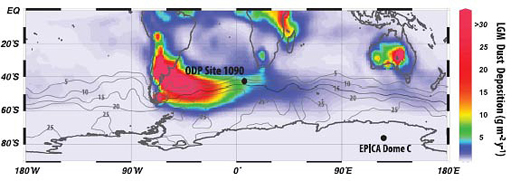
Nitrogen is a critical building block for marine algae, yet the plankton in the Southern Ocean north of Antarctica leave much of it unused partly because they lack another needed nutrient, iron. The late John Martin hypothesized that dust-borne iron carried to the region by winds during ice ages may have fertilized the marine algae, allowing more of the Southern Ocean nitrogen to be used for growth and thus drawing CO2 into the ocean. To confirm Martin’s hypothesis, the researchers measured isotopes of nitrogen in a sediment sample collected from a site that lies within the path of the winds that deposit iron-laden dust in the Subantarctic zone of the Southern Ocean (labeled ODP Site 1090). They found that the ratios of the types of nitrogen in the sample coincided with the predictions of Martin’s hypothesis. The colors indicate simulated ice-age dust deposition from low to high (blue to red). The black contour lines show the concentrations of nitrate (a form of nitrogen) in modern surface waters. (Image courtesy of Alfredo Martínez-García of ETH Zurich and Science/AAAS)
